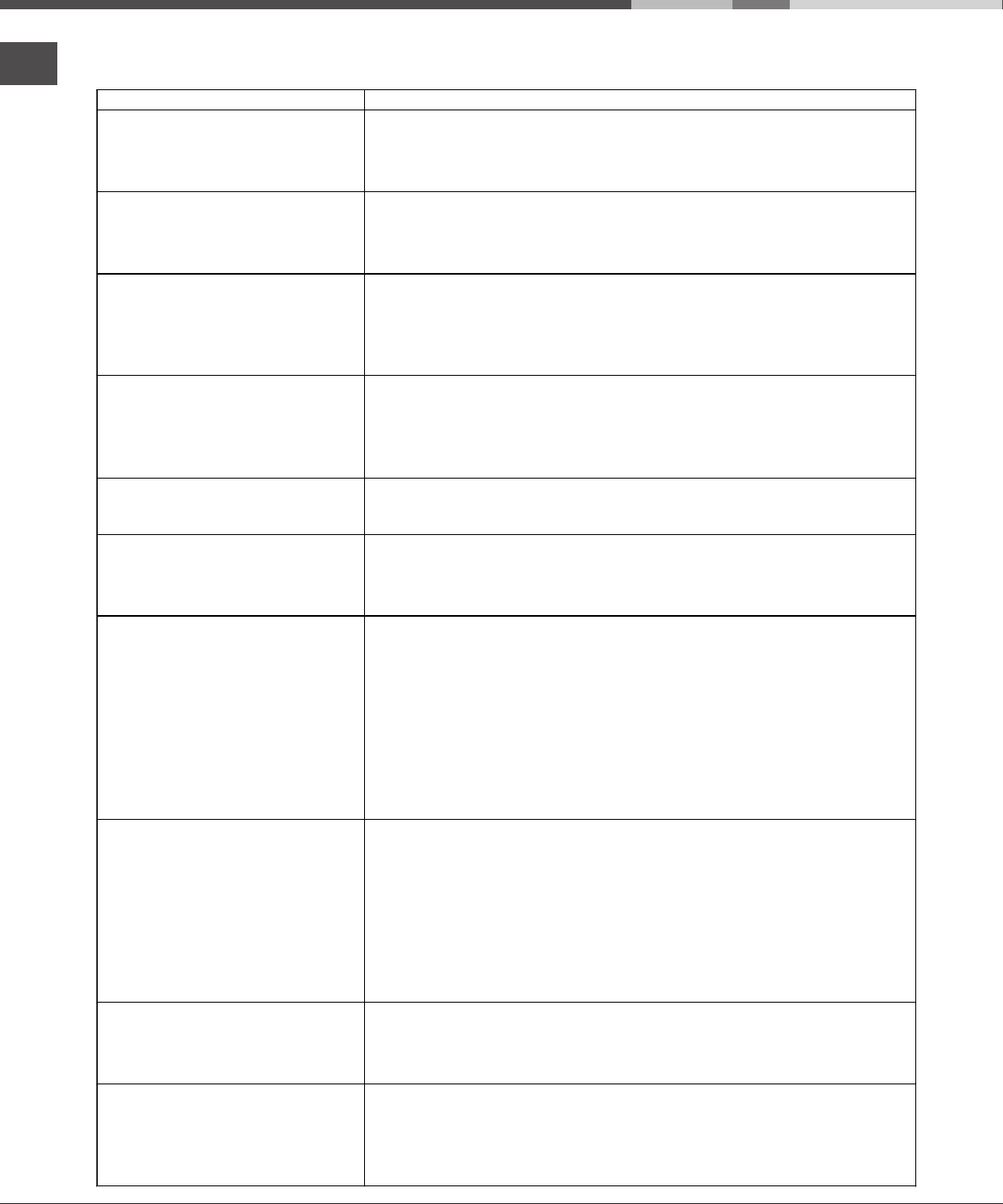
14
EN
Whenever the appliance fails to work, check for a solution from the following list before calling for Assistance
(see Assistance).
Troubleshooting
Malfunction: Possible causes / Solutions:
The dishwasher does not start.
• The plug has not been inserted into the electrical socket properly, or
there is no power in the house.
• The dishwasher door has not been shut properly.
• A delayed start has been programmed (see Start-up and use).
No water drains out from the
dishwasher.
• The dishwasher cycle has not yet finished.
• The water outlet hose is bent (see Installation).
• The drain duct is blocked.
• The filter is clogged up with food residues.
The dishwasher makes
excessive noise.
• The dishes are rattling against each other or against the sprayer
arms.
• An excessive amount of foam has been produced: the detergent has
not been measured out correctly or it is not suitable for use in
dishwashers (see Start-up and use).
The dishes and glasses are
covered in a white film or
limescale deposits.
• The level of the refined salt is low or the dosage setting is not
suited to the hardness of the water (see Rinse aid and salt).
• The lid on the salt dispenser is not closed properly.
• The rinse aid has been used up or the dosage is too low.
• The crockery is made from non-stick material.
The dishes and glasses are
streaked or have a bluish
tinge.
• The rinse aid dosage is too high.
The crockery has not been dried
properly.
• The rinse aid has been used up or the dosage is too low (see Rinse
aid and salt).
• The rinse aid dispenser setting is not high enough.
• A wash cycle without a drying programme has been selected.
The dishes are not clean.
• The racks are overloaded (see Loading the racks).
• The crockery has not been arranged well.
• The sprayer arms cannot move freely.
• The wash cycle is too gentle (see Wash cycles).
• An excessive amount of foam has been produced: the detergent has
not been measured out correctly or it is not suitable for use in
dishwashers (see Start-up and use).
• The lid on the rinse aid compartment has not been shut correctly.
• The filter is dirty or blocked (see Care and maintenance).
• The refined salt level is low (see Rinse aid and salt).
No water enters the
dishwasher/Shut off tap alarm.
(several short beeps are emitted)
(the 2 (Normal) and 3 (Soak) WASH
CYCLES indicator lights flash).
• There is no water in the mains supply.
• The water inlet hose is bent (see Installation).
• Turn on the tap and the appliance will start after a few minutes.
• The appliance lock has been activated because no action was taken
when the beeps sounded. Switch off the machine, using the ON/OFF
button, turn on the tap and switch the machine back on after 20
seconds by pressing the same button. Re-programme the machine
and restart the wash cycle.
Water loading solenoid valve
malfunction alarm
(the 2 (Normal) WASH CYCLE
indicator lights flash).
• Switch off the machine by pressing the ON/OFF button and switch it
back on after a minute. If the alarm continues, turn off the water tap
to reduce the risk of flooding, remove the plug from the electrical
socket and call Assistance.
Water inlet hose alarm/Water inlet
filter blocked.
(the 1 (Intensive), the 2 (Normal) and
the 3 (Soak) WASH CYCLES
indicator lights flash).
• Switch off the appliance by pressing the ON/OFF button. Shut off
the water tap to eliminate the risk of flooding and remove the plug
from the electrical socket.
Make sure the water inlet filter has not become blocked by various
impurities. (see “Care and maintenance” chapter).


















